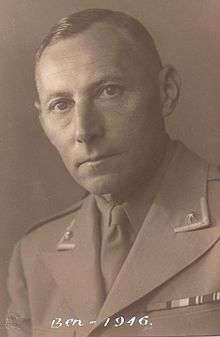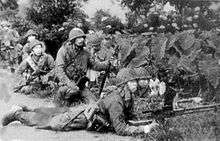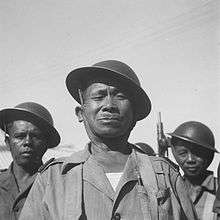Battle of Manado
| Battle of Manado | |||||||
|---|---|---|---|---|---|---|---|
| Part of World War II, Pacific War | |||||||
| |||||||
| Belligerents | |||||||
|
|
| ||||||
| Commanders and leaders | |||||||
|
|
| ||||||
| Strength | |||||||
| 1,500 infantry |
2,500 naval infantry 500 paratroopers 20 aircraft | ||||||
| Casualties and losses | |||||||
|
140 killed 48 captured |
32 killed 32 wounded | ||||||
The Battle of Manado was a battle of the Pacific Theatre of World War II. It occurred at Manado (also spelled Menado) on the Minahasa peninsula on the northern part of the island of Celebes (now known as Sulawesi), from 11–13 January 1942 as an attempt to open a passage to attack Australia through the eastern part of Dutch East Indies.
Defences in Manado
The Dutch force at Manado area numbered approximately 1,500 men under command of Major B.F.A. Schillmöller.[2]
- Compagnie Menado; a native unit 188 men strong. This company was reinforced with two or three Vickers machine-gun sections and was commanded by Captain W.F.J. Kroon.
- Mobiele Colonne; this mobile unit had about 45 men and was commanded by Sergeant-Major A.J. ter Voert. It was intended to be used against Japanese paratroopers.
- Reserve Korps Oud Militairen (RK); this unit was made up from five companies of retired KNIL personnel with an average age of over 50 and was commanded by Captain W.C. van den Berg.
- Kort Verband Compagnie (KV) of nine brigades[3] under the command of Captain J.D.W.T. Abbink.
- Europese Militie en Landstorm Compagnie (European Militia); about 200 men strong but poorly trained. Commanded by 1st Lieutenant F. Masselink.
- Menadonese Militie Compagnie (Native Militia); about 400 native troops under the command of Captain J.H.A.L.C. de Swert.
- Stadswacht (Home Guard); about 100 men strong armed with old hunting rifles and commanded by 1st Lieutenant M.A. Nolthenius de Man.
- Two artillery guns (75 mm (2.95 in) Lang 35 Model 1902)
- Three very old 37 mm (1.46 in) naval guns; placed on trucks, they were used to defend Lake Tondano.
With such a limited force, Major Schillmöller had to defend the airfields at Langoan (Langowan) (Manado II) and at Mapanget (Manado I), the naval base at Tasoeka and Manado.[2]

Japanese forces and planning
The main Japanese fleet—which launched the attack on the eastern Dutch East Indies—was under the command of Vice-Admiral Ibō Takahashi, and was intended to land at Manado, Kendari, Ambon, Makassar, Timor and Bali.[1] The Imperial Japanese Navy planned to use the Sasebo Combined Landing Force as well as the Yokosuka 1st SNLF as a paratrooper unit.[5]
Sasebo Combined Landing Force
The Combined Sasebo SNLF was about 2,500 men strong under the command of Captain Kunizo Mori. It had been formed temporarily from the Sasebo 1st SNLF and the Sasebo 2nd SNLF units.[6] A company of Type 95 Ha-Go light tanks was attached to the unit.[2] The Combined Sasebo SNLF would depart Davao on 9 January, and the assault would occur in the early hours of 11 January.[2] The Sasebo 1st SNLF would land on the coast of the peninsula on both sides of Manado town, occupy it, then advance toward Kakas the following day. The Sasebo 2nd SNLF would land at Kema on the southeast side of the peninsula and advance towards Kakas and Lake Tondano.[2]
1st Yokosuka SNLF

The 1st Yokosuka SNLF was a paratrooper unit under Commander Toyoaki Horiuchi. The troops would fly about 380 mi (610 km) from Davao, Philippines and jump over Langoan to capture the airfield.[2] The 1st Drop Group would jump at 09:30 on 11 June[5] It consisted of 334 men, organized into a HQ unit (44 men), a Signal unit (14 men) and two rifle companies (139 men and 137 men respectively). The 1st Company would attack Langoan while the 2nd Company would capture the seaplane base at Kakas.
The 2nd Drop Group, consisting of the 3rd Company, would jump on Langoan airfield on 12 June as reinforcements. Twenty-two men would depart on the 11th aboard two Kawanishi H6K5 "Mavis" flying boats and land on Lake Tondano. This group consisted of an AT gun unit (10 men) armed with a 37mm AT gun and a medical section (11 men).
The Mitsubishi G3M transport aircraft of the 1st Yokosuka SNLF would fly with an interval of 1,500 m (4,900 ft) between each company, with 10 aircraft for the 1st and 2nd Companies and eight aircraft for the 3rd Company. Each plane carried 12 paratroopers and seven cargo containers. The drops would occur at an altitude of 500 ft (150 m) and at a speed of 100 kn (120 mph; 190 km/h).
Navy Ships
Teikoku Kaigun (Imperial Japanese Navy).[2] The convoy was escorted by Rear-Admiral Raizo Tanaka[7] with
- 2nd Destroyer Flotilla
- Light Cruiser Jintsu (flagship)
- 8th Destroyer Division (1st Group): Oshio, Asashio
- 15th Destroyer Division: Natsushio, Kuroshio, Oyashio, Hayashio
- 16th Destroyer Division: Yukikaze, Tokitsukaze, Hatsukaze, Amatsukaze
The Japanese airforce was under command of Rear-Admiral Ruitaro Fujita[8] with
- 11th Seaplane Division
- Seaplane carrier Chitose
- Seaplane carrier Mizuho
- Patrol boat P 39
Base Force was under command of Rear-Admiral Kyuji Kubo[9] with
- 1st Base Force
- Light cruiser Nagara (flagship)
- Patrol boats - P 1, P 2, P 34
- 21st Minesweeper Division
- Minesweepers - W 7, W 8, W 9, W 11, W 12
- 1st Submarine-chaser Division
- Submarine chasers - Ch 1, Ch 2, Ch 3
Covering Force was under command of Rear-Admiral Takeo Takagi.[10]
- 5th Cruiser Squadron
- Heavy cruisers - Nachi (flagship), Haguro, Myoko
- 6th Destroyer Division (2nd Group)
- Destroyers - Ikazuchi, Inazuma
Landing on Manado
The unit of Compagnie Menado—which numbered only 188 men under Captain W.F.J. Kroon and Landstorm Compagnie with its 200 troops under 1st Lieutenant F. Masselink—were not enough to oppose the thousands of Japanese troops which conducted the amphibious assault at 04:00 on 11 January 1942. Initially, when the defense failed, they were instructed to retreat to Tinoör stronghold, located some 5 mi (8.0 km) inland. After some sporadic fights and due to poor communication, instead of defending Tinoör-line, the Compagnie Menado had to move to Koha. Tinoör was defended by Lieutenant van de Laar from Reserve Korps Oud Militairen (RK) and the reinforcement from Landstorm Compagnie under 1st. Lt. Masselink. The fighting at Tinoör lasted until 15:00 when the KNIL ran out of ammunition and had to retreat to Kakaskasen.
Landing on Kema
The Reserve Korps Oud Militairen (RK)—under the command of Lieutenant Radema—was responsible for the defence of Kema. He had two of his brigades[3] placed along the coast line and one at his CP at Ajermadidih (Airmadidi). The rest of the company had to defend Mapanget airfield, Likoepang (Likupang) and Bitoeng (Bitung).
The landings at Kema started at 03:00 on 11 January and were made swiftly. The Japanese transport ships quickly left the area. When Radema heard about the Japanese landing he immediately ordered his troops to regroup at Ajermadidih. When the first Japanese troops, including three tanks, reached Ajermadidih at 09:00, Radema tried to stop the Japanese advance with few available troops. But at last, Radema had to withdraw from Ajermadidih and planned to start a guerrilla war. However due to high rate of native troops desertion, he had to give up this plan.
The airborne attack

The defence of Lake Tondano and the airfield at Longoan was under the responsibility of the so called Tactical Command Kakas with commanding officer Captain W.C. van den Berg. Kakas is a small town name near Lake Tondano. The airfield itself was defended by the 41 brigades[3] under the command of 1st Lieutenant J.G. Wielinga. This unit was reinforced with one of the overvalwagens (armoured car[11]). Wielinga had his command post at the kampong Langoan, where he held 11 brigades[3] back in reserve. The rest of his troops and the overvalwagen were placed at the airfield. Sergeant-Major H.J. Robbemond was in command.
Shortly after 09:00 on 12 January, 334 Japanese paratroopers were dropped on and around the airfield. Having heard the dropping, Captain van den Berg ordered the two remaining overvalwagens to attack the airfield. Although the Japanese paratroopers suffered heavy casualties, they succeeded in capturing the Langoan airfield. Enraged by the heavy losses, the Japanese executed a large number of KNIL POW's. Knowing that the battle was lost, van den Berg ordered his remaining troops to retreat inland and start a guerrilla war.
The guerrilla war

In several places, the remaining KNIL forces tried to start a guerrilla war against the Japanese invaders. Captain Kroon assembled what was left of the Menado Compagnie (about 50 men) and retreated toward Kembes, hoping to start an active guerrilla from this place. Due to regular desertions by his native soldiers he reached Kembes with only nine men left. Here the group was taken prisoner by the Japanese. All European members, except Kroon himself, were executed at Langoan on 16 January.
Sergeant Maliëzer from E-Company did not want to surrender and started a guerrilla force with fifteen of his men. On 8 February, they attacked a Japanese unit at Kanejan. The fighting lasted the whole day, and the Japanese counter-attack failed. Outraged, they burned nearby Kampung and executed five civilians (including two women). On 12 February, they came back with a larger force, and this time captured Maliëzers group. Maliëzer too was executed at Langoan with twelve of his men.
Captain van den Berg's and his group were taken prisoner on 20 February. His group, made up of pensioners, attacked the Japanese units on several occasions and inflicted heavy casualties. Out of respect for the high average age and fighting spirit, the Japanese commander spared their lives.
Capture of Kendari
Kendari is a small town on southeast Celebes, facing the Banda Sea in Mollucas (Maluku). Nonetheless, it had an important position for the Japanese to become an airbase from which the bombers and airplanes could attack Soerabaja and Kupang in West Timor. Soerabaja was the main Dutch naval base in Dutch East Indies.[12]
After securing Manado, in the night of 23/24 January 1942 the Japanese Sasebo Combined Special Naval Landing Force moved southward and landed at north of Kendari. Kendari airfield was quickly secured with little resistance. By the evening of 24 January, Kendari was fully occupied. Most of the 400-strong Dutch KNIL troops led by Captain F.B. van Straalen were captured by Japanese.[12]
Kendari Air Base became the base for the Japanese 21st Air Flotilla operation. Slightly south of Kendari, a main naval base at Staring Bay was constructed to become an important refuelling checkpoint in that area. The bombers involved in Bombing of Darwin (February 1942) were flown from Kendari.
Notes
- 1 2 L, Klemen (1999–2000). "Vice-Admiral Ibo Takahashi". Forgotten Campaign: The Dutch East Indies Campaign 1941–1942.
- 1 2 3 4 5 6 7 L, Klemen (1999–2000). "The Fall of Menado, January 1942". Forgotten Campaign: The Dutch East Indies Campaign 1941–1942.
- 1 2 3 4 Each brigade was an independent formation and usually had 15-18 men apiece.
- ↑ Ben Schillmoller photo courtesy Schillmoller family
- 1 2 Donaldson, Graham (1999–2000). "The Japanese paratroopers in the Dutch East Indies, 1941–1942". Forgotten Campaign: The Dutch East Indies Campaign 1941–1942.
- ↑ Yaklitch, Mike; Alsleben, Allan; Takizawa, Akira (1999–2000). "Japanese Special Naval Landing Forces". Forgotten Campaign: The Dutch East Indies Campaign 1941–1942.
- ↑ L, Klemen. "Rear-Admiral Raizo Tanaka". Forgotten Campaign: The Dutch East Indies Campaign 1941–1942.
- ↑ L, Klemen. "Rear-Admiral Ruitaro Fujita". Forgotten Campaign: The Dutch East Indies Campaign 1941–1942.
- ↑ L, Klemen (1999–2000). "Rear-Admiral Kyuji Kubo". Forgotten Campaign: The Dutch East Indies Campaign 1941–1942.
- ↑ L, Klemen (1999–2000). "Rear-Admiral Takeo Takagi". Forgotten Campaign: The Dutch East Indies Campaign 1941–1942.
- ↑ afnuyt. "Army Overvalwagens". Overvalwagens! - Kaleidoscope of military vehicles of the Dutch East and West Indies before 1945.
- 1 2 L, Klemen (1999–2000). "The Fall of Kendari, January 1942". Forgotten Campaign: The Dutch East Indies Campaign 1941–1942.
References
- L, Klemen (1999–2000). "Forgotten Campaign: The Dutch East Indies Campaign 1941–1942".
- afnuyt. "Overvalwagens! - Kaleidoscope of military vehicles of the Dutch East and West Indies before 1945".
Further reading
Coordinates: 1°9′48″N 124°51′26″E / 1.16333°N 124.85722°E